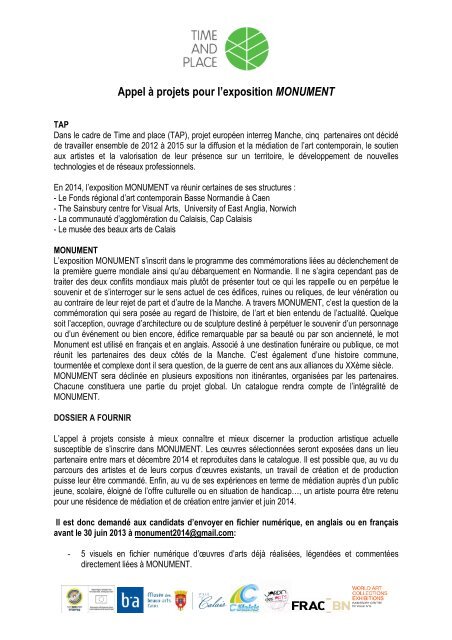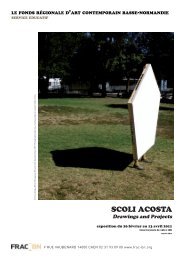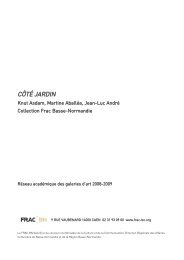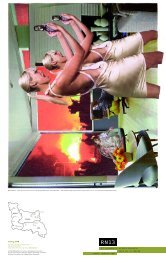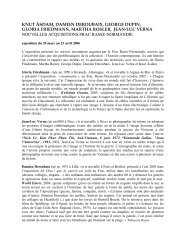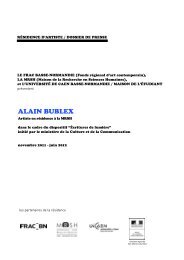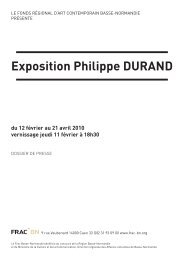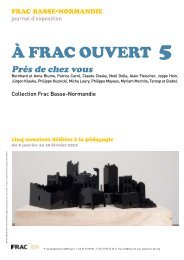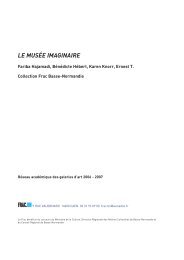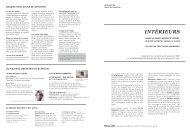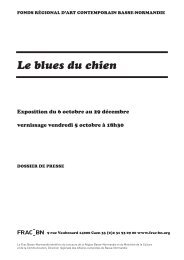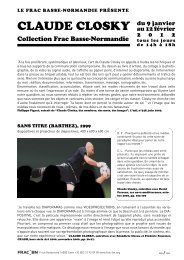APPEL A PROJETS MONUMENT TAP - FRAC Basse-Normandie
APPEL A PROJETS MONUMENT TAP - FRAC Basse-Normandie
APPEL A PROJETS MONUMENT TAP - FRAC Basse-Normandie
Create successful ePaper yourself
Turn your PDF publications into a flip-book with our unique Google optimized e-Paper software.
Appel à projets pour l’exposition <strong>MONUMENT</strong><br />
<strong>TAP</strong><br />
Dans le cadre de Time and place (<strong>TAP</strong>), projet européen interreg Manche, cinq partenaires ont décidé<br />
de travailler ensemble de 2012 à 2015 sur la diffusion et la médiation de l’art contemporain, le soutien<br />
aux artistes et la valorisation de leur présence sur un territoire, le développement de nouvelles<br />
technologies et de réseaux professionnels.<br />
En 2014, l’exposition <strong>MONUMENT</strong> va réunir certaines de ses structures :<br />
- Le Fonds régional d’art contemporain <strong>Basse</strong> <strong>Normandie</strong> à Caen<br />
- The Sainsbury centre for Visual Arts, University of East Anglia, Norwich<br />
- La communauté d’agglomération du Calaisis, Cap Calaisis<br />
- Le musée des beaux arts de Calais<br />
<strong>MONUMENT</strong><br />
L’exposition <strong>MONUMENT</strong> s’inscrit dans le programme des commémorations liées au déclenchement de<br />
la première guerre mondiale ainsi qu’au débarquement en <strong>Normandie</strong>. Il ne s’agira cependant pas de<br />
traiter des deux conflits mondiaux mais plutôt de présenter tout ce qui les rappelle ou en perpétue le<br />
souvenir et de s’interroger sur le sens actuel de ces édifices, ruines ou reliques, de leur vénération ou<br />
au contraire de leur rejet de part et d’autre de la Manche. A travers <strong>MONUMENT</strong>, c’est la question de la<br />
commémoration qui sera posée au regard de l’histoire, de l’art et bien entendu de l’actualité. Quelque<br />
soit l’acception, ouvrage d’architecture ou de sculpture destiné à perpétuer le souvenir d’un personnage<br />
ou d’un événement ou bien encore, édifice remarquable par sa beauté ou par son ancienneté, le mot<br />
Monument est utilisé en français et en anglais. Associé à une destination funéraire ou publique, ce mot<br />
réunit les partenaires des deux côtés de la Manche. C’est également d’une histoire commune,<br />
tourmentée et complexe dont il sera question, de la guerre de cent ans aux alliances du XXème siècle.<br />
<strong>MONUMENT</strong> sera déclinée en plusieurs expositions non itinérantes, organisées par les partenaires.<br />
Chacune constituera une partie du projet global. Un catalogue rendra compte de l’intégralité de<br />
<strong>MONUMENT</strong>.<br />
DOSSIER A FOURNIR<br />
L’appel à projets consiste à mieux connaître et mieux discerner la production artistique actuelle<br />
susceptible de s’inscrire dans <strong>MONUMENT</strong>. Les œuvres sélectionnées seront exposées dans un lieu<br />
partenaire entre mars et décembre 2014 et reproduites dans le catalogue. Il est possible que, au vu du<br />
parcours des artistes et de leurs corpus d’œuvres existants, un travail de création et de production<br />
puisse leur être commandé. Enfin, au vu de ses expériences en terme de médiation auprès d’un public<br />
jeune, scolaire, éloigné de l’offre culturelle ou en situation de handicap…, un artiste pourra être retenu<br />
pour une résidence de médiation et de création entre janvier et juin 2014.<br />
Il est donc demandé aux candidats d’envoyer en fichier numérique, en anglais ou en français<br />
avant le 30 juin 2013 à monument2014@gmail.com:<br />
- 5 visuels en fichier numérique d’œuvres d’arts déjà réalisées, légendées et commentées<br />
directement liées à <strong>MONUMENT</strong>.
- une biographie qui intègrera avec précision le parcours de formation et les diplômes, la<br />
participation à des expositions individuelles ou collectives, les aides et bourses obtenues, les<br />
expériences professionnelles en termes de médiation le cas échéant<br />
- une bibliographie ou/et revue de presse<br />
- un texte de présentation générale de la démarche artistique<br />
- une adresse web/site pour consulter d’autres informations<br />
Les informations devront comportées obligatoirement :<br />
- Nom, Adresse, Contacts (adresse de messagerie et téléphone)<br />
- Titre(s) de l’œuvre (s)<br />
Description de l’œuvre et sa relation au thème <strong>MONUMENT</strong><br />
Matériaux<br />
Dimensions<br />
Poids<br />
Spécificités de l’accrochage ou de l’installation<br />
Valeur d’assurance<br />
Location actuelle<br />
- Visuels ( 5 maxi)<br />
- Lieux d’exposition privilégié<br />
Choix 1 :<br />
Choix 2 :<br />
Choix 3 :<br />
- Niveau d’anglais (pour les francophones) et de français (pour les Anglophones) : fluide, moyen, faible<br />
- Cette déclaration signée :<br />
Je soussigné (e) déclare que l’œuvre ou les œuvres décrites seront disponibles en 2014 et<br />
m’engage à ne pas demander de frais d’exposition.<br />
CAEN, <strong>FRAC</strong> BASSE NORMANDIE<br />
A Caen , c’est bien entendu au regard de la guerre que le monument s’érige ici ou là aussi bien dans la<br />
ville que sur la côte toute proche où eut lieu le Débarquement du 6 juin 1944 . L’ensemble des plages<br />
du Débarquement de Ouistreham à Arromanches sont autant de lieux de mémoire avec de nombreux<br />
petits musées dédiés, monuments aux soldats des unités britanniques, canadiennes et américaines,<br />
chars exposés mais aussi bunkers oubliés. La Pointe du Hoc, restée territoire américain est un lieu<br />
symbole. Les cimetières américains et allemands très contrastés sont à eux seuls des monuments.<br />
Les artistes Diller & Scofidio ont publié avec le Frac <strong>Basse</strong>-<strong>Normandie</strong> en 1994 le livre « Visite aux<br />
armées : tourismes de guerre» qui interroge cet après.
La ville elle-même bombardée par les alliés et détruite à 70 % conserve cependant une quarantaine<br />
d’églises qui furent parfois des refuges pour les populations et recèle par contre très peu de<br />
monuments ; à signaler cependant, le monument d’Anna Quinquaud, 1962 qui commémore les 19<br />
jours de la bataille de Caen ; l’œuvre Phénix, 1954 du sculpteur Louis Leygue située à l’entrée de<br />
l’Université marque le renouveau du lieu comme de la ville. De nombreuses petites stèles<br />
commémoratives sobres et fleuries sont disséminées dans la ville et rendent hommages aux forces<br />
alliées, aux combattants français ou encore aux fusillés et déportés.<br />
La commande publique récente au cœur de la ville, La Caravane, œuvre de l’artiste contemporain Joep<br />
van Lieshout qui sera inaugurée courant 2013 constitue par ses 11 personnages aussi un hommage<br />
aux vivants en temps de guerre.<br />
L’année 2014 année du 100e anniversaire de la guerre 1914-18 et du 70e anniversaire du<br />
Débarquement en <strong>Normandie</strong> donnera lieu à un certain nombre de cérémonies commémoratives.<br />
Le Mémorial de la Paix accueille de très nombreux visiteurs (http://www.memorialcaen.fr/portail/index.php?option=com_content&view=article&id=788&Itemid=1295)<br />
Frac <strong>Basse</strong> <strong>Normandie</strong><br />
Fonds regional d’art contemporain <strong>Basse</strong>-<strong>Normandie</strong><br />
9 rue Vaubenard 14000 Caen<br />
France<br />
www.frac-bn.org<br />
Contact : Sylvie Froux, directrice<br />
CALAIS, MUSEE DES BEAUX-ARTS<br />
A Calais le monument s’érige quasi exclusivement en regard de la guerre. Peu d’édifices ont survécu<br />
aux bombardements alliés anglais de 1940. De l’ancienne ville de Calais, il ne subsiste que 80% de son<br />
architecture. Parmi ses vestiges, la Tour du guet, ancien phare, peu entretenue et Notre Dame de<br />
Calais, église monumentale de style Tudor en cours de restauration et bientôt d’achevée. La sculpture<br />
monumentale traditionnelle est circonscrite essentiellement aux parcs et à l’espace public. La ville est<br />
marquée par les nombreuses fortifications de l’ancien régime et les bunkers du XXème siècle, en ruine<br />
pour la plupart. Ils ponctuent la ville, de la plage aux abords des canaux. Des blockhaus, construits<br />
entre 1940 et 1942 par les allemands pour se protéger des attaques anglosaxonnes, un seul est encore<br />
utilisé. Il abrite le musée de la mémoire 39-45, camouflé derrière les arbres d’un parc. L’architecture<br />
défensive a transformé le paysage calaisien depuis des siècles. Les bunkers au sein de cette ville<br />
frontière de bord de mer n’en finissent pas d’imposer leur présence malgré leur état de ruine. Signe de<br />
la réprobation de toute une époque pour la guerre, le bunker du Pas de Calais a été érigé comme un<br />
point central dans l’organisation défensive et offensive de la stratégie de guerre totale du régime nazi<br />
sans pour autant avoir beaucoup servi. Aujourd’hui les bunkers réhabilités en musée de la guerre ou de<br />
la mémoire sur tout le littoral ainsi que les bases de lancement sont très visitées par les touristes et<br />
groupes scolaires.<br />
Un autre monument à Calais, Les Bourgeois de Calais, rappelle l’histoire tumultueuse des liens franco<br />
britanniques pendant la guerre de cent ans. En effet Rodin a choisi de représenter un épisode des
Chroniques de Froissart, décrivant six calaisiens, décidés à se sacrifier pour libérer la ville assiégée par<br />
le roi anglais Edouard III depuis plusieurs mois.<br />
Musée des beaux-arts de Calais<br />
25 Rue Richelieu<br />
Calais<br />
France<br />
www.musee.calais.fr<br />
Contact : Barbara Forest, directrice<br />
COMMUNAUTE D’AGGLOMERATION DU CALAISIS, JARDIN DES ARTS<br />
Finalités de la résidence en milieu scolaire<br />
Une résidence-mission, relevant du programme jardin des arts, est organisée à des fins<br />
d’éducation artistique et culturelle en faveur d'un public d’enfants, d'adolescents et de jeunes d'âge<br />
scolaire. Elle repose sur une pleine disponibilité de l'artiste, durant trois à quatre mois, ainsi que sur une<br />
diffusion importante de son œuvre déjà accomplie et disponible, en lieux dédiés ou non. La résidencemission<br />
peut avoir pour finalité de proposer une « création » ; résultat d’un processus lié à la rencontre<br />
de l’artiste et du territoire.<br />
Pour l’artiste-résident il s’agit, plus particulièrement, de s'engager dans une démarche éducative<br />
donnant à voir et à comprendre la recherche artistique qui l'anime ainsi que les processus de création<br />
qu'il met en œuvre (réflexion, expérimentations, réalisation). Cette mise en évidence s'appuie sur des<br />
formes d'intervention ou d'actions très variées.<br />
Tel un laboratoire d’éducation artistique se menant à l' échelle d'un territoire bien défini, ces actions sont<br />
à préparer en amont avec diverses équipes pédagogiques et/ou équipes éducatives.<br />
Elles sont aussi préparées avec les équipes en charge des structures culturelles implantées sur le<br />
territoire ou y œuvrant momentanément.<br />
Ces actions se menant, en temps scolaire ou hors scolaire, ont pour objectif de permettre à un grand<br />
nombre d'enfants, d'adolescents et de jeunes (et au-delà, de leurs familles) d’acquérir une expérience<br />
originale et sensible de l'œuvre. Ces actions peuvent avoir lieu aussi bien au sein des établissements<br />
scolaires, de centres sociaux, de centres de loisirs, de structures culturelles que dans l’espace public ou<br />
tout autre site qui paraîtra approprié à l’artiste-résident et à ses partenaires locaux.<br />
Enjeux et objectifs<br />
- Permettre au plus grand nombre d'enfants, d'adolescents et de jeunes d’appréhender la création<br />
contemporaine en provoquant la rencontre et une certaine familiarisation avec une démarche artistique<br />
forte, en lien avec un réseau de lieux culturels ;<br />
- Développer l’esprit critique de ces enfants, adolescents et jeunes par le biais de la discussion,<br />
d'échanges, de<br />
lecture d’œuvres ;<br />
- Contribuer au développement culturel et artistique du territoire, et plus particulièrement à une<br />
éducation<br />
artistique cohérente, intercommunale, mutualisant les énergies de ses multiples acteurs ;<br />
- Contribuer à réduire ainsi les inégalités en matière d’accès à l’art et à la culture.
SAINSBURY CENTRE FOR VISUAL ARTS, UNIVERSITY OF EAST ANGLIA, NORWICH<br />
Deux sites seront utilisés à Norwich pour le projet Monument, l’un sera en lien direct avec la Première<br />
Guerre Mondiale. Au centre de la ville, l’Hôtel de ville se tient juste au-dessus de la place du Marché<br />
(qui est le plus ancien marché permanent d’Angleterre). En dessous de l’Hôtel de ville et construit en<br />
1938, sur le même plan, les jardins du memorial se situent entre l’hôtel de ville et le marché, envisagé<br />
à l’origine comme un “oasis de paix'. Au Coeur des jardins, le memorial à la guerre 14-18 réalisé par<br />
Sir Edwin Lutyens . Un espace enterré en béton sous le memorial, connu sous le nom the Undercroft -<br />
est utilisé pour le stockage des stands du marché adjacent mais il est maintenant dédié à des<br />
installations d’art contemporain choisies en accord avec son usage d’origine. Cet heritage ainsi que son<br />
esthétique exigenate et industrielle associé à un accès immediat de la population diversifiée du centre<br />
ville sont des opportunités particulières offertes par ce site.<br />
Des oeuvres seront sélectionnées pour cet espace et seront exposées pendant l’été 2014 en même<br />
temps que l’exposition <strong>MONUMENT</strong> présentée au Sainsbury Centre for Visual Arts. C’est une galerie et<br />
un centre d’enseignement et de recherches sur le campus de l’Université d’East Anglia, à 3 kilomètres<br />
du centre de Norwich, dans la region du Norfolk, dans l’est de l’Angleterre. Un bâtiment conçu<br />
spécialement pour Le Sainsbury Centre for Visual Arts par Norman Foster en 1978 et classé monument<br />
historique l’abrite. Il est amené à s’étendre et à se rénover par l’architecte; comme récemment en 2013<br />
avec le nouvel aménagement des espaces d’exposition. Les activités fondamentales du Centre se<br />
fondent sur la collection d’art universel de Sir Robert and Lisa Sainsbury qui couvre plus de 5,000<br />
années, incluant des oeuves d’art de L’Afrique, de l’Asie, des Amériques, de l’Europe et du Pacifique et<br />
qui est reconnue pour les oeuvres qu’elle détient d’artistes du 20 ème siècle comme Henry Moore,<br />
Alberto Giacometti and Francis Bacon.<br />
Sainsbury Centre for Visual Arts<br />
University of East Anglia<br />
Norwich NR4 7TJ<br />
Norfolk<br />
UK<br />
www.scva.ac.uk<br />
Contact : Veronica Sekules, Deputy Director (programme)
Call for projects on the subject of <strong>MONUMENT</strong><br />
<strong>TAP</strong><br />
Under the general heading of Time and Place (<strong>TAP</strong>) five institutional partners are working together from<br />
2012-2015 on a cross-channel Interreg project. This involves a programme connecting the exhibition,<br />
mediation and education of contemporary art alongside the encouragement and professional<br />
development of artistic practice and the development of tools and technologies for dissemination<br />
throughout the cross-channel region and beyond.<br />
in 2014, the exhibition <strong>MONUMENT</strong> will unite the partner institutions:<br />
- The Frac <strong>Basse</strong> <strong>Normandie</strong> at Caen<br />
- Sainsbury centre for Visual Arts, University of East Anglia, Norwich<br />
- The communauté d’agglomération du Calaisis, Cap Calaisis<br />
- le musée des beaux arts de Calais<br />
<strong>MONUMENT</strong><br />
In 2014 the exhibition <strong>MONUMENT</strong> will be dedicated to the commemorations on either side of the<br />
Channel of the Hundredth anniversary of the First World War, as well as to the seventieth anniversary of<br />
the Normandy landings (?). However, rather than being literally devoted to the subject of the world<br />
wars, we aim to treat the theme very broadly, interrogating the subject in terms of all the legacies and<br />
ideas of war, all its vestiges, edifices, ruins and relics, and equally in terms of their veneration and their<br />
rejection.<br />
The word Monument exists in parallel and in almost the same senses in English and French. In both<br />
languages, around the idea of monument and its commemoration are associations with history, art and<br />
indeed real events and news. It may be celebrated in works of architecture, or sculpture dedicated to the<br />
commemoration of a personality or an event, or indeed, be enshrined in a building remarkable for its<br />
beauty or its antiquity, in an installation, or in a more fragile or ephemeral medium such as film or<br />
drawing. Whether associated with a funerary or public context the concept thus unites the exhibitions on<br />
both sides of the Channel. It enables us to explore and call into question a common history, tormented<br />
and complex, from the Hundred Years War to the Twentieth Century.<br />
<strong>MONUMENT</strong> will be dedicated to a number of separate exhibitions organised by the partners. Each one<br />
will form part of the global project. A single catalogue will bring the entire project together.<br />
Information for your application<br />
This call for projects aims to provide us with a clear idea of current existing work which is relevant to the<br />
<strong>MONUMENT</strong> theme, for selection for each of the partner venues and for inclusion in the catalogue. It is<br />
possible that once entries have been received and viewed that some further work will be selected for a<br />
commission. Also, in the light of any experience offered in education, mediation and participatory or<br />
performative projects, it is possible that an artist may be employed for a residency at one of the partner<br />
venues between yanuary and june 2014.<br />
Applications may be sent in the preferred language, English or French by 30 june 2013 at :<br />
monument2014@gmail.com<br />
- 5 images in a numbered file of existing works of art, in any medium, titled and commented upon<br />
in terms of the theme of <strong>MONUMENT</strong>.<br />
-
- A Curriculum vitae detailing experience and qualifications, exhibitions, awards and fellowships,<br />
and professional experience in terms of mediation/ education/ performance.<br />
- A bibliography or press review/s.<br />
- A general statement about your artistic practice (not more than 500 words).<br />
- A website for consulting with reference to any further information.<br />
Entry form<br />
- Name, Address, Contact details – e mail, phone, mobile<br />
- Title of work<br />
Description and relationship to the theme of <strong>MONUMENT</strong><br />
Medium<br />
Size<br />
Weight<br />
Display specification<br />
Value<br />
Current location<br />
- Images ( 5 maxi)<br />
- Preferred place of showing<br />
1 st choice<br />
2 nd choice<br />
3 rd choice<br />
- Signed declaration that the work is available to lend for the period of the exhibitions in 2014 and no<br />
fees will be demanded for the exhibition.<br />
- Is your competence in spoken English (for French people) or French (for english people) :<br />
a) fluent b) average c) poor<br />
CAEN, <strong>FRAC</strong> BASSE NORMANDIE<br />
With reference to war, it is well understood in Caen, that the idea of <strong>MONUMENT</strong> is evoked within the<br />
town just as much as on the nearby coast, the sites of the Allied Landings of 6 June 1944. The group of<br />
landing beaches from Ouistreham to Arromanches are as much places of memory as are the numerous<br />
small museums dedicated to the subject, the exposed tanks, as well as the hidden bunkers, all being<br />
monuments to the soldiers of the British, Canadian and American allies. La Pointe du Hoc remains as<br />
American territory and is a symbolic place. The American and German cemeteries, contrasting as they<br />
are, exist as monuments in themselves.<br />
The artists Diller and Scofido published the book: ‘Visite aux armées: tourismes de guerre’ (Visit the<br />
Armies: the Tourism of War) with the <strong>FRAC</strong> <strong>Basse</strong> <strong>Normandie</strong> in 1994.
The town itself, bombed by the allies and 70% destroyed, nevertheless preserves some 40 churches,<br />
which acted at times as refuges for the populations and received (on the other hand) a very small<br />
number of monuments; indicated by the monument of Anna Quinquaud, 1962, which commemorates<br />
the 19 days of the battle of Caen; the work Phénix (Phoenix), 1954, of the sculptor Louis Leygue,<br />
situated at the entrance of the University, which marks the renovation of the place and of the town.<br />
Numerous little simple and decorative commemorative slabs are distributed throughout the town and<br />
pay homage to the allied forces, to the French combatants, or also, to the riflemen and prisoners.<br />
The recent public commission at the heart of the town, La Caravane (The Caravan / Retinue), a work by<br />
the contemporary artist Josep van Lieshout, which has been inaugurated recently in 2013, creates<br />
through its 11 figures, a homage which is equally dedicated to the living in times of war.<br />
The year 2014, the year of the 100 th anniversary of the 1914-1918 war and the 70 th anniversary of the<br />
Normandy landings gives the opportunity for a number of commemorative ceremonies.<br />
Le Mémorial de la Paix (The Peace Memorial) welcomes a great number of visitors.<br />
http://www.memorial-caen.fr/portail/index.php?option=com_content&view=article&id=788&Itemid=1295<br />
Frac BN<br />
Fonds regional d’art contemporain <strong>Basse</strong>-<strong>Normandie</strong><br />
9 rue Vaubenard 14000 Caen<br />
France<br />
www.frac-bn.org<br />
Contact : Sylvie Froux, directrice<br />
CALAIS, FINE ART MUSEUM<br />
In Calais the monument exists almost exclusively in relation to war. Few buildings survived bombings by<br />
English allies of 1940. The old town of Calais has lost 80% of its architecture. Among the remains are<br />
the Tour du Guet, the ancient lighthouse, small remains of Notre Dame de Calais, the monumental<br />
church in Tudor style in course of restoration and almost complete. Monumental and traditional<br />
sculpture is largely confined to parks and public spaces. The town is remarkable for its numerous<br />
fortifications from the Ancien Regime, and for its bunkers of the 20 th century, mostly in ruins. They<br />
punctuate the town, the beach, the banks of the canals. Of the defensive structures constructed<br />
between 1940 and 1942 by the Germans for protecting against attack by the English, only one survives<br />
in use. It contains the museum to the memory of the 39-45 war, camouflaged behind the trees of a<br />
park. Defensive architecture has over the centuries transformed the countryside around Calais. The<br />
bunkers within this frontier town by the sea impose a strong presence in spite of their ruinous state.<br />
Evidence of its dominance by war for a whole epoch, the bunker of the Pas de Calais was erected as a<br />
central point of the defensive and offensive strategy for the whole Nazi war without ever having served<br />
as such. Today the bunkers are rehabilitated as a war museum, and of which the outline structure as<br />
well as the firing shafts are much visited by school-children and tourists.<br />
Another Calais monument, the Burghers of Calais of 1888, recalls the tumultuous history of the Franco-<br />
British conflicts during the Hundred Years War. In effect, Rodin chose to represent an episode from the
Chronicles of Froissart, depicting six Calais men who sacrificed themselves in order to liberate the town<br />
which had been under siege for several months by the forces of the English king Edward 111.<br />
Musée des beaux-arts de Calais<br />
25 Rue Richelieu<br />
Calais<br />
France<br />
www.musee.calais.fr<br />
Contact : Barbara Forest, Directrice<br />
COMMUNAUTE D’AGGLOMERATION DU CALAISIS, JARDIN DES ARTS<br />
Aims of the educational residency<br />
A residency programme relevant to the programme ‘Jardin des Arts is organised under the remit of<br />
artistic and cultural education for a public of children, adolescents and young people of school age. It<br />
depends on an artist being fully available for 3 or 4 months as well as ensuring an important<br />
dissemination of his or her existing work, whether in a dedicated space or not.<br />
The outcome of the residency can be a proposal for creation of a new work, its making resulting from<br />
the process of encounter between the artist and the region.<br />
For the resident artist it is particularly important to engage in an educational approach which gives<br />
explicit access to the further understanding of the research process, and to the creative reflection which<br />
leads to the work (reflection, experimentation, and the process of making). This making evident of the<br />
process can take many forms in terms of interventions or actions.<br />
Such a laboratory of artistic education might lead up to well defined territory, however, its actions and<br />
events need to be prepared for an eventual relationship with many different educational and pedagogic<br />
offices and clients. They also need to be prepared and negotiated with the bodies in charge of the<br />
cultural organisations embedded in the region where the artist is temporarily situated.<br />
These actions are intended to lead, during school hours or after school, to the objective to permit a large<br />
number of children, adolescents and young people (and beyond to their families) to acquire first hand<br />
experience with the creation of original works of art. These actions can take place equally in schools,<br />
social centres, leisure centres, cultural organisations, or in public spaces, or in any other site which is<br />
deemed appropriate by the artist and his or her local partners.<br />
Aims and objectives:<br />
• To permit a great number of children, adolescents and young people to learn about the creation<br />
of contemporary works of art in the course of an encounter with a powerful artistic intervention,<br />
in connection with a network of cultural spaces.<br />
• To develop the critical faculties of these children, adolescents and young people through<br />
discussion, exchanges of ideas, talks on the works.<br />
• To contribute to the cultural and artistic development of the region and particularly towards a<br />
coherent artistic education, which is community focussed, and integrating the energies of the<br />
many contributors.
• To contribute in this way to reducing the inequalities of access to art and culture.<br />
SAINSBURY CENTRE FOR VISUAL ARTS, UNIVERSITY OF EAST ANGLIA, NORWICH<br />
Two sites will be used in Norwich for the <strong>MONUMENT</strong> project, one of them with a direct relationship to<br />
the First World War. In the very centre of the city, the City Hall stands just above the market-place<br />
(which is the oldest continuing market in England). Below City Hall and built in 1938, as part of the<br />
same scheme, the memorial gardens sit between the City Hall and the market, originally intended as an<br />
'oasis of peace'. At the heart of the gardens is a memorial to the 1914-18 war by Sir Edwin Lutyens . A<br />
cavernous concrete space directly beneath the memorial – known as the Undercroft - has recently been<br />
used as storage for the adjacent market stalls but is now being used for contemporary art installations<br />
which are in broad sympathy with its original purpose. That legacy, plus its challenging and somewhat<br />
industrial aesthetic together with immediate access to a diverse city-centre population, are the particular<br />
opportunities offered by this site.<br />
Work will be selected for this space to be shown in the summer of 2014 concurrently with the<br />
<strong>MONUMENT</strong> exhibition at the Sainsbury Centre for Visual Arts. This is a gallery and centre for teaching<br />
and research on the campus of the University of East Anglia, 2 miles from Norwich city centre, in<br />
Norfolk, East Anglia. The Centre is housed in a purpose-built, grade II listed building designed by<br />
Norman Foster in 1978 and subject to further expansion and refurbishment by the architect – most<br />
recently with the redesign of the temporary exhibition spaces in 2013. Core to the activities of the<br />
Centre is the World Art collection of Sir Robert and Lisa Sainsbury which spans some 5,000 years,<br />
including work from Africa, Asia, the Americas, Europe and the Pacific and renowned for its holdings of<br />
works by 20 th century artists such as Henry Moore, Alberto Giacometti and Francis Bacon.<br />
Sainsbury Centre for Visual Arts<br />
University of East Anglia<br />
Norwich NR4 7TJ<br />
Norfolk<br />
UK<br />
www.scva.ac.uk<br />
Contact : Veronica Sekules, Deputy Director (programme)


